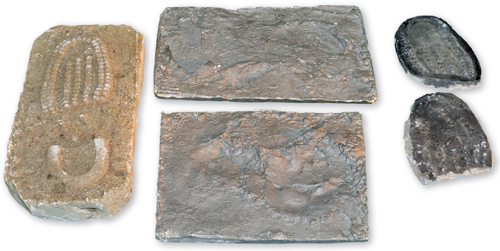
THE PAPILLARY RIDGE patterns on human fingers also apply to human palms and, therefore, the possibility of identifying criminals from their finger marks became extended to palm marks left at the scenes of crimes. In this example, the palm mark was left on a metal marker from a golf course.
When the body of Mrs Elizabeth Currell was found on 29 April 1955 on Potters Bar golf course, it became apparent that the murder weapon was a heavy iron tee marker. The wound to Currell’s skull displayed green paint from the marker and could be matched by an exact ‘mechanical’ fit. There was a partial palm print found on the tee marker, but it did not match any in Scotland Yard’s collection. The offender was believed to be a local man, so, after careful consideration, the police launched a public appeal and invited male occupants of homes in the area to provide their palm prints for elimination purposes. By the middle of that August, four months later, 9,000 palm prints had been taken when a member of a special squad of fingerprint officers found the print that was a match for the mark found at the crime scene. The palm print belonged to a youth named Michael Queripel who lived with his parents close to the golf course. Queripel first admitted only to finding the body, but then admitted the complete crime and was detained ‘at Her Majesty’s pleasure’. He was the first to be convicted as the result of a mass palm-printing exercise.
The precedent for the public appeal for elimination prints had taken place in 1948. A particularly traumatic murder case occurred on 14 May that year when 4-year-old June Devaney was found to be missing from a children’s ward at Blackburn’s Queen’s Park hospital. She was later found battered to death in the hospital grounds. Detective Chief Inspector Colin Campbell, head of the Lancashire Fingerprint Bureau, found marks made by stockinged feet on the hospital ward floor, but there was a second clue that came in the form of a finger mark on a ‘Winchester’ bottle that must have been moved by the perpetrator. It was a time-consuming task to take the fingerprints of all the hospital staff who might have touched the bottle for legitimate reasons, and the mark did not match any in Scotland Yard’s national fingerprint collection. The mass public fingerprinting exercise proposal gained the support of the local population, who were encouraging of any efforts to catch the man responsible. With the assistance of the notable fingerprint expert Frederick Cherrill, the police undertook the enormous task of taking the fingerprints of all the male population of Blackburn to eliminate them from their inquiry. This exercise took weeks, and more than 46,000 sets of fingerprints were taken without any positive result. It was the era of post-war rationing and records of the issue of ration books were then compared with the national registration numbers recorded on the fingerprint forms, and the police realised that there were 200 men who had not yet been seen. Priority was then given to tracing these men, amongst which was set number 46,253 that provided, at long last, a match with the mark on the bottle. The fingerprints belonged to Peter Griffiths. He was hanged on 19 November 1948; two weeks after, all of the other elimination prints were destroyed.
It was in the case of John Egan in 1931, prosecuted for a series of burglaries, that palm-print evidence was first produced in a prosecution in a British court. There had been a clear palm print left by the burglar at one of the crime scenes, and when Egan was arrested on other evidence, Frederick Cherrill, then a detective inspector, went to Brixton prison and took Egan’s palm prints for comparison purposes. One of Egan’s prints matched the mark left on a glass table at the crime scene. This gave fresh impetus to the collection of palm prints, since at the time Scotland Yard had only a very limited collection – it was generally only fingerprints that were taken routinely from prisoners. Egan pleaded guilty, but the judge called Cherrill to the witness box to inform the court about the development and as an assurance that palm print identification was as reliable as fingerprints.
By 1942, Scotland Yard had collected 4,000 palm prints and Cherrill was a detective superintendent. When a 71-year-old pawnbroker named Leonard Moules was murdered in East London, Detective Chief Inspector Ted Greeno called in Cherrill to examine the scene for finger marks. Cherrill found a palm print inside a safe that matched neither the victim, nor his assistant nor any of those in Scotland Yard’s collection. In an inquiry reminiscent of the Stratton brothers’ case, one witness recalled that he had seen two men near the scene whom he knew vaguely as ‘George’ and ‘Sam’. This led to the men being identified as George Silverosa and Sam Dashwood who were then arrested as suspects. Their palm prints were taken, and one of Silverosa’s matched that found in the victim’s safe. Both prisoners blamed each other and refused to give evidence at their trial, which was the first contested trial involving a palm print. They were convicted, and executed at Pentonville prison on 10 September 1942.

1937
Plaster casts of Leslie Stone’s knee and shoe marks